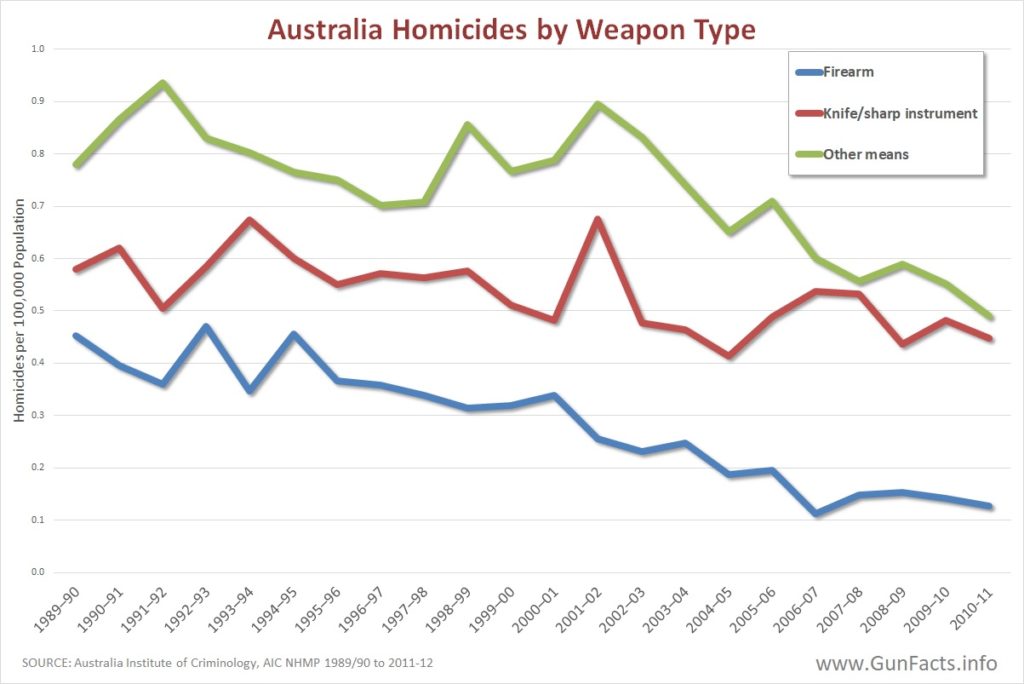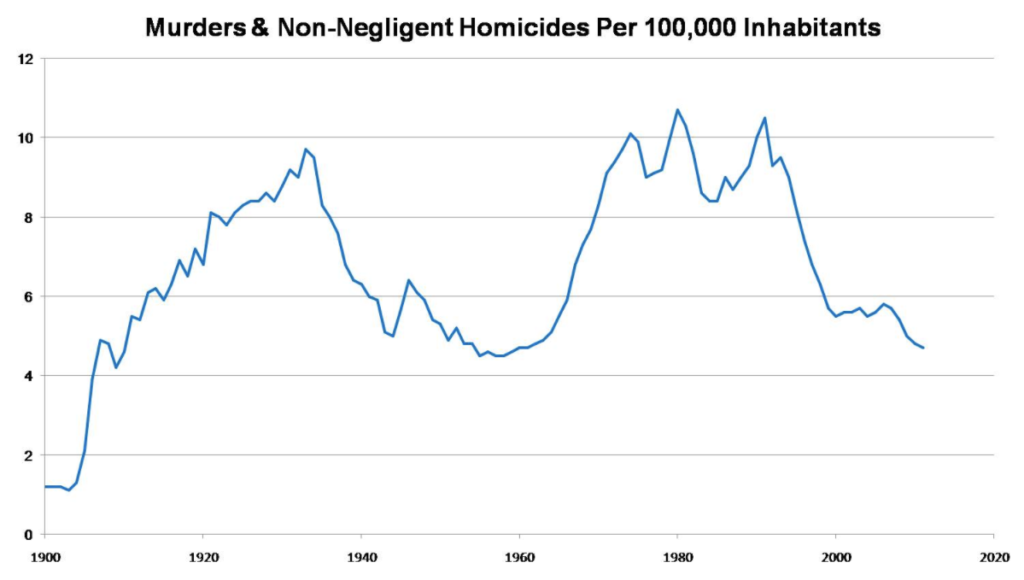After every tragedy involving a gun, there is a sudden cry from millions calling for various gun bans and controls. Do I support these measures or not? My idea of the best use for a gun is to recycle it into a farming implement. What does the evidence suggest will happen if we do that immediately?
One of the most prominent bans on guns was in Australia in 1996. Let’s examine the Slate article praising Australia’s ban. I’ll discuss some of the key points.

Total homicides did not begin their decline in Australia until 2003, seven years after the ban took effect. The decline in gun deaths began immediately and slowly.[1] Gun homicides went down while the total homicides went slightly up. We must conclude that there was a ‘corresponding increase in non-firearm-related homicides’. And there was:

Murdering Australians have never preferred killing each other with guns. They prefer knives and other methods. When guns were banned, they just used other means to kill each other for a while. The decline in homicides that began in 2003 was, more than anything else, led by the decline in “other means” homicides. Australians, much to their credit, just don’t want to kill each other as much anymore.
The wider point is that the decline in homicides in Australia just continued the trends that were already in place. The current decades-long decline matches that of other countries, including the U.S. The U.S., for example, experienced a substantial drop over the time period immediately following Australia’s ban.

At best the gun ban had no effect on homicides at all. At worst it resulted in greater crime and homicides. Either way, it was not a positive effect.

Unlike the nearly non-existent effect on homicides, the drop in suicides by firearm was sudden and profound. The key question is whether or not the drop in gun-related suicide deaths resulted in a corresponding increase in suicides by other means.

In 1996 suicide rates were elevated at ~14 per 100,000. In 1997, immediately after the ban, the rate peaked at 18.4 per 100,000. Thereafter the rate declined to its lowest point of 9 per 100,000 in 2005. As of 2015 the rate was back up to 12.6. In 100 years of tracking the statistic, the rate of suicides among Australians has remained relatively flat in the 12.5±5 per 100,000 range. The current suicide rate appears to be near the historical mean.
If banning guns reduces suicides, why did the suicide rate spike immediately following the ban? However, in the next few years there was definitely some suggestion of correlation as suicide rates plunged along with total gun deaths. Nevertheless, any effect was only temporary, given current rates. Those who want to kill themselves have, unfortunately, found other ways to accomplish their plans. Moreover, the decline in suicides spanned a decade, suggesting that the ban was not the primary cause.

The data used by the Slate article has been carefully cherry-picked to make it seem like there was a huge positive benefit to banning firearms. Robbery involving a firearm decreased, but victims of robbery increased by a greater proportion, remaining elevated for seven years following the ban. This is a particularly heinous misrepresentation as a common claim by those who oppose bans is that removing guns leads to an increase in crime.
Over the same period of time shown in the above graph, the violent crime rate in the U.S. declined and did so significantly.[2] During this time, millions of guns were sold in the U.S.
Mass and school shootings do indeed decline if guns are removed. Given the relative rarity of these events, the costs and benefits must be weighed. Australia’s example does not inspire confidence that a gun ban would result in a positive outcome, and that’s ignoring the cultural and Constitutional problems that are unique to the United States.
Moreover, the evidence indicates that banning guns will result in more violence and death. Advocates for gun control should be careful not to advocate evil in the name of politics.
[1] It took years for gun-related homicides to fall substantially after the gun ban took effect. It didn’t decline until other factors declined faster.
[2] The crime rates in Australia were already quite low to begin with. The gun ban was in response to a problem that Australia really didn’t have. The same cannot be said for the U.S., where the crime rates had much more room to fall. So while we can only draw limited conclusions from these statistics, the simplistic claim that banning guns will result in a noticeable improvement in crime rates is not supported by this evidence. If anything, the conclusion is the opposite: that banning guns will result in a noticeable increase in crime.
[3] Caveat emptor: Wikipedia claims that the specific definition of mass shooting used here was used in the following paper used to show that Australia’s gun law was successful.
Chapman, S. (December 2006). “Australia’s 1996 gun law reforms: faster falls in firearm deaths, firearm suicides, and a decade without mass shootings”. Injury Prevention. 12: 365–72. doi:10.1136/ip.2006.013714. PMC 2704353. PMID 17170183
There may be other mass shootings that don’t qualify under this particular definition. Researching this is out of scope for this article, but those basing their public policy on this should understand that they are not comparing apples-and-oranges to the more broadly inclusive definitions used in the U.S.

Pingback: Do People Kill People?